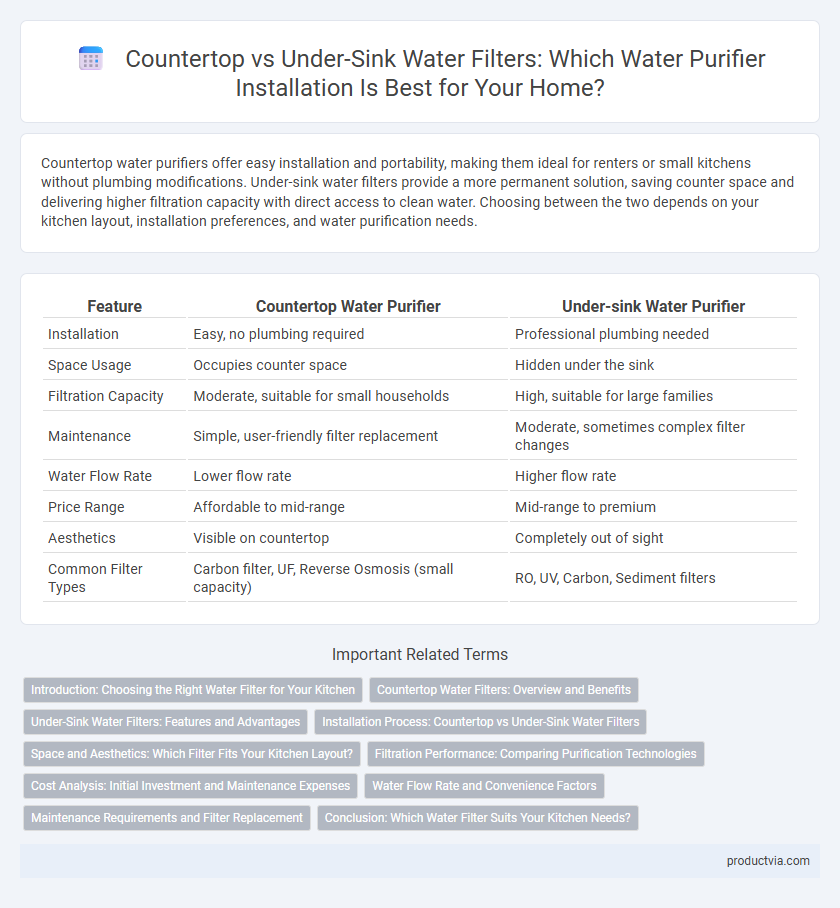Countertop water purifiers offer easy installation and portability, making them ideal for renters or small kitchens without plumbing modifications. Under-sink water filters provide a more permanent solution, saving counter space and delivering higher filtration capacity with direct access to clean water. Choosing between the two depends on your kitchen layout, installation preferences, and water purification needs.
Table of Comparison
| Feature | Countertop Water Purifier | Under-sink Water Purifier |
|---|---|---|
| Installation | Easy, no plumbing required | Professional plumbing needed |
| Space Usage | Occupies counter space | Hidden under the sink |
| Filtration Capacity | Moderate, suitable for small households | High, suitable for large families |
| Maintenance | Simple, user-friendly filter replacement | Moderate, sometimes complex filter changes |
| Water Flow Rate | Lower flow rate | Higher flow rate |
| Price Range | Affordable to mid-range | Mid-range to premium |
| Aesthetics | Visible on countertop | Completely out of sight |
| Common Filter Types | Carbon filter, UF, Reverse Osmosis (small capacity) | RO, UV, Carbon, Sediment filters |
Introduction: Choosing the Right Water Filter for Your Kitchen
Countertop water purifiers offer easy installation and portability, ideal for renters or those seeking convenience without plumbing changes. Under-sink filters provide a more permanent solution with higher filtration capacity and hidden installation, preserving kitchen aesthetics. Evaluating water quality needs, space availability, and maintenance preferences helps determine the optimal choice between countertop and under-sink water filters.
Countertop Water Filters: Overview and Benefits
Countertop water filters offer easy installation and portability, making them ideal for renters or those seeking a non-permanent solution. These filters typically use activated carbon or ceramic technology to effectively reduce chlorine, sediment, and contaminants, ensuring clean and great-tasting water. Their compact design fits conveniently on kitchen counters, providing quick access to purified water without the need for plumbing modifications.
Under-Sink Water Filters: Features and Advantages
Under-sink water filters offer space-saving installation by fitting discreetly beneath the sink, maintaining a clutter-free countertop while providing direct access to purified water through a dedicated faucet. These systems typically feature multi-stage filtration, including activated carbon and reverse osmosis, effectively removing contaminants such as chlorine, lead, and bacteria, ensuring high water quality. Maintenance is user-friendly with easy cartridge replacements, making under-sink water filters a durable and efficient solution for continuous access to clean drinking water.
Installation Process: Countertop vs Under-Sink Water Filters
Countertop water filters offer a straightforward installation process, requiring no plumbing modifications and can be easily connected to the kitchen faucet, making them ideal for renters or those seeking a portable solution. Under-sink water filters demand professional or DIY plumbing work to install beneath the sink, involving valve and pipe adjustments, which provide a more permanent setup with hidden hardware. While countertop models prioritize convenience and mobility, under-sink filters offer discreet installation for a cleaner countertop appearance.
Space and Aesthetics: Which Filter Fits Your Kitchen Layout?
Countertop water purifiers offer easy installation and portability, making them ideal for smaller kitchens or renters with limited space. Under-sink filters optimize kitchen aesthetics by keeping the unit hidden, preserving countertop space and creating a cleaner look. Choosing between these options depends on available space, desired visibility, and how much you prioritize maintaining a streamlined kitchen design.
Filtration Performance: Comparing Purification Technologies
Countertop water purifiers typically use activated carbon and UV light to effectively reduce chlorine, sediment, and bacteria, offering quick installation without plumbing changes. Under-sink systems often employ multi-stage filtration, including reverse osmosis or ultrafiltration, providing higher contaminant removal rates such as lead, arsenic, and nitrates for enhanced water purity. Selecting between the two depends on desired filtration performance, space availability, and specific water quality concerns.
Cost Analysis: Initial Investment and Maintenance Expenses
Countertop water purifiers generally require a lower initial investment, with prices ranging from $50 to $300, compared to under-sink systems that typically cost between $150 and $600. Maintenance expenses for countertop models are usually reduced due to easier filter replacements and fewer parts, whereas under-sink filters often incur higher ongoing costs, including professional installation and more frequent filter changes. Evaluating long-term operational costs reveals that under-sink systems might demand greater financial commitment despite offering space-saving benefits.
Water Flow Rate and Convenience Factors
Countertop water purifiers typically offer higher water flow rates, making them ideal for households needing quick access to filtered water without installation hassles. Under-sink filters provide a more discreet solution, conserving countertop space but often have lower flow rates due to complex plumbing integration. Convenience factors like ease of maintenance and installation also differ, with countertop models being more user-friendly and under-sink systems requiring professional setup and periodic filter replacements out of sight.
Maintenance Requirements and Filter Replacement
Countertop water purifiers typically require simpler maintenance with easily accessible filters that users can replace without professional help, making them ideal for convenience. Under-sink water filters often need more complex installation and periodic professional servicing, as their filters can be harder to reach and replace. Regular filter replacement frequency varies, with countertop models usually needing changes every 3-6 months, while under-sink systems often extend to 6-12 months depending on water quality and usage.
Conclusion: Which Water Filter Suits Your Kitchen Needs?
Countertop water filters offer easy installation and portability, ideal for renters or those with limited space, while under-sink systems provide a discreet, permanent solution with higher filtration capacity. Consider water quality, kitchen layout, and maintenance preferences when choosing between these options. Selecting the right water purifier depends on balancing convenience, filtration performance, and your household's specific water consumption patterns.
Countertop vs Under-sink for water filters Infographic

 productvia.com
productvia.com